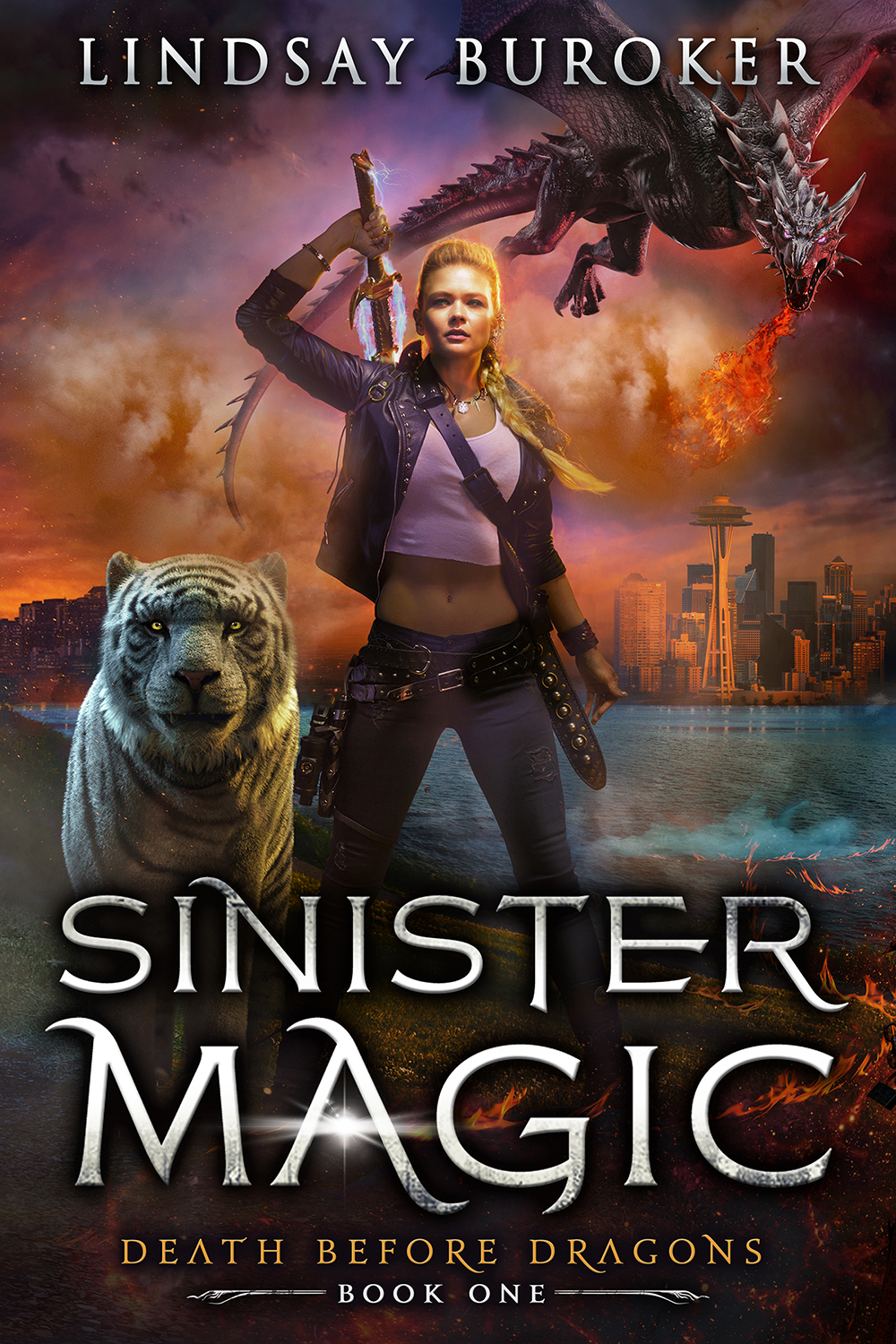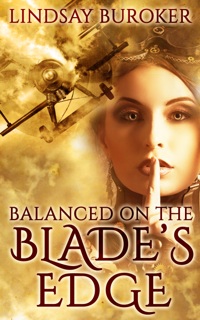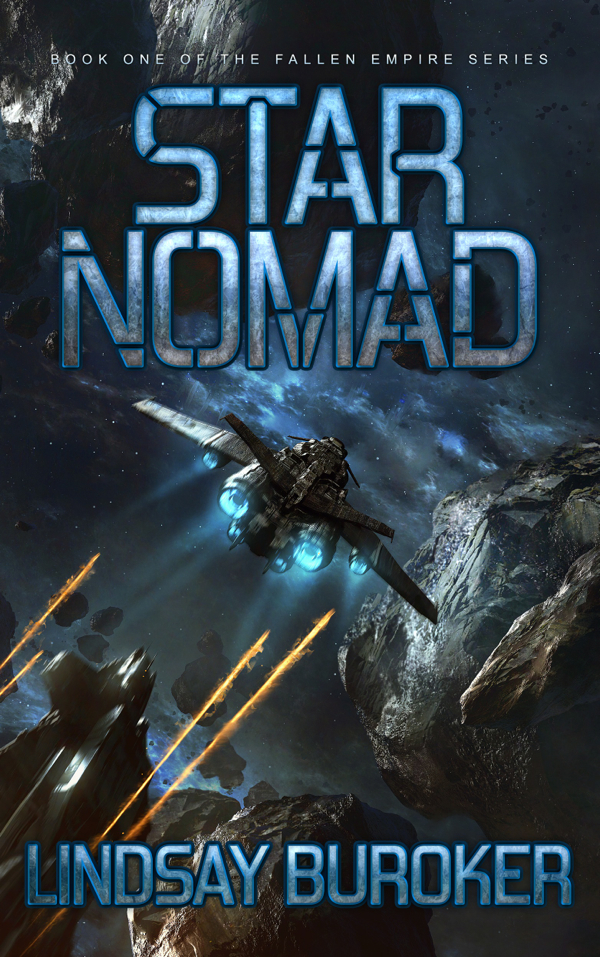If you’re an indie author, you’ve probably heard this advice: write in a series and publish often. If you genre hop, your readers won’t follow you. If you have too many series going at once, you’ll struggle to build momentum and hit critical mass. Just focus!
It’s not bad advice. It comes from the business side of publishing, the side that’s focused on selling books and making money.
But writers are usually artists first and entrepreneurs later (if at all). As artists, we like to dabble. We’re always getting new ideas that we want to explore. For some of us, the urge to genre hop cannot be resisted!
But is it a career killer? Will all of your momentum grind to a halt as your mystery/thriller fans side-eye that fantasy romance you just published?
Let’s be honest: it won’t help things.
It’s rare to see someone who writes in fantasy this month, romance next month, and horror the month after that gaining a big audience and making a living as an author. Those who do manage to genre hop successfully are usually very prolific so they’re able to publish something new in each genre/series every few months, even as they explore other passions.
In general, though, genre hopping comes with challenges. Fans of one genre won’t necessarily be fans of another, so you essentially have to build up multiple fan bases. It’s easier to stick to one genre and become known for a certain type of book.
But if you’re reading this, it’s probably because you’re thinking of genre hopping anyway. So, how do you do it and manage to succeed?
How to Successfully Genre Hop
I’ve failed with genre hopping, and I’ve also done it right (with my pen name). Even though that pen name is fairly neglected these days, you can go back to 2014 and read the posts I wrote at the time when I launched it, where I anonymously started a new name to write science fiction romance: reporting in after one month and reporting in after 10 weeks.
Admittedly, starting a pen name isn’t quite the same as jumping into a new genre under your existing name, but it’s the best example I’ve got right now, as least from my own previously published novels. I’m about to launch a new series under my name, a science fiction adventure series, so I’ve definitely been thinking about how to give myself a good chance of gathering momentum and garnering readers (and sales!) in the new genre. As you probably know, almost everything else written under my name is fantasy. There’s only one exception, a contemporary mystery/sweet romance/thing that’s a pretty good example of what not to do when jumping into a new genre.
I wrote that story a few years ago without thinking about whether it fit neatly into any established sub-genres out there (note: it doesn’t). I had no idea what to do for the cover (note: it shows). I believe that book earned out editing and cover art costs, but not much more. It’s sitting at a sales ranking of about 300,000 in the Amazon store these days. Only my die-hard readers check it out. I’m fairly certain that nobody who wasn’t already a fan ever found it and read it.
So based on my various learning experiences (failures and successes), here’s what I’m trying with the new series and what I suggest for others doing the same:
Commit to Writing Multiple Books in a Series to Launch in the New Genre
I probably would have more luck with the one-off mystery/romance if I’d turned it into a series, and at the time I was planning to write more of them. I set things up so there could be at least two more romances with the characters introduced in the first book. (And heck, I may still go back and write those stories one day.)
But I launched the book without having any sequels started or any solid commitment as to when I would publish them. I didn’t have a big launch strategy either. I basically emailed my list and said, “Hey, here’s a new book if you want to try it. There’s no magic in it. Or sword fights. Or dragons. Enjoy!”
Needless to say, it didn’t skyrocket to the top of any charts.
This time, I’m doing what I did with the pen name launch (by the way, if you’re thinking, “Hey, your pen name stuff is closer in genre to this new science fiction adventure, so maybe you should be launching it under your pen name,” you’re right, except that LB stuff is PG-13, and the pen name stuff is naughtier). My new series isn’t naughty (alas).
I wrote the first three books in the new SF series (Fallen Empire) before I even sent the first one to my editor. I’m launching Books 1, 2, and 3 back to back. The first one goes up this week, May 26th, and I’ll probably throw 2 and 3 out less than a week apart. They’re all just about ready to go now.
My reason for doing this is in part because I hope to gain some momentum with the rapid releases, and it’s also in part to help me commit to writing several books in the series. Sometimes, if you just write one and put it out there, and it doesn’t do that well, it’s easy to get discouraged and never get around to writing the follow-ups. (That’s what happened to me with Wounded.)
I’m 30,000 words into Book 4 now, before Book 1 ever launches. I told myself I’d write five books in this series before sitting back and seeing if it’s worth continuing or if I should then try to wrap it up. I’ll publish 4 a month after 3 and 5 a month after 4. (Sometime after that, I might need a vacation.)
This is all designed to give the new series a good start and to try to make some Top 100 lists over on Amazon where new readers (readers who prefer science fiction adventures to swords and dragons!) might find it. Because even though I have awesome readers already, and even though some of them will try out the new books, it’s a foregone conclusion that I’ll have to attract some new SF-loving readers if I want the books in the new genre to sell well.
It’s very hard to find those new readers and do well if you only have one book out in the new genre. There’s a lot of churn on Amazon especially, but on the other sites too. It’s hard to keep books ranking in a category over time. But continually publishing new books in a series can help with that, by constantly giving you something new for the Hot New Releases lists and by keeping your name and series out there where people can stumble across it. If they find Book 3 or Book 5 and think they look interesting, chances are they’ll go and look for Book 1.
Consider a Low (or even free) Launch Price for Book 1
Even if you’re an established author in your regular genre, readers in the new one may never have heard of you. By launching at 99 cents (or even considering free), people may take the leap of faith and give your stuff a try. Because you’ve committed to writing at least two more stories in the series (and may already have them written), you don’t need to cringe at the idea of only making 35 cents per sale. You have two more books out, or coming out soon, that the readers can go on to buy at full price.
When I launched the pen name books, I made Book 1 permafree everywhere as quickly as I could. I paid for a few inexpensive ads for it, and ended up getting about 20,000 downloads in that first 8 weeks or so. Not bad for a pretty niche little genre. (And I wasn’t even writing the popular tropes within that niche genre.) I made thousands of dollars in those first couple of months, thanks to strong sales of the 2nd and 3rd books.
Perhaps not surprisingly, when, several months later, I made that book 99 cents so I could put it into Kindle Unlimited, sales dropped off. Even though Amazon’s KDP Select lets you make a book free for 5 days a quarter, it’s not quite the same as always having it free and continually being able to advertise it. I’ll probably eventually make that series wide (I think KU can be helpful when you’re launching a series, which I’ll talk about next, but once your books drop out of the Top 100s, it becomes less useful.)
Consider Amazon’s KDP Select and Kindle Unlimited (exclusivity with Amazon) for the Launch
This is advice that could change in the future, since Amazon is always tinkering with KDP Select and the Kindle Unlimited subscription program, but for the last year, I’ve been seeing a lot of newer authors come out of nowhere and hit and stick in the various Top 100 category lists (in case you didn’t know, I’m one of the hosts on the Science Fiction & Fantasy Marketing Podcast, and we interview a lot of different guests). Almost all of those authors were in KDP Select (in fact, I can actually name the one and only debut author selling well who wasn’t, because it’s that rare right now).
The reason KDP Select/Kindle Unlimited is such a help currently is because it’s easier to get a borrow of a book (from a KU subscriber) than it is to get a sale. That’s just common sense. And for the time being, all of those borrows count as strongly as sales in Amazon’s sales ranking calculations. That means that an author who isn’t exclusive with Amazon might being selling 50 books a day to maintain his sales ranking whereas a KDP Select author might only sell 20 books a day and get 30 borrows to maintain a similar ranking. In the Amazon store,it’s an advantage to be in KDP Select (and it’s a disadvantage if you’re not).
If you’re not already selling like hotcakes on the other platforms, then you may want to start off the new genre/series in KDP Select. I actually sell reasonably well on Barnes & Noble and Kobo, in particular, but after seeing so many people doing well with the help of Kindle Unlimited, I’ve finally decided to try a series there.
Since it doesn’t tie in with anything else I’ve written, and nobody’s yet dying to know about these characters, it seemed like the logical time. I’m expecting some pushback from readers anyway. We’ll see how it goes. My current plan is try the series there for the first 90-180 days and see if it’s worthwhile. I.e. am I making much more because I’m in Kindle Unlimited than I would be if those books were wide? Whether or not that’s the case, I expect the momentum for the series to have faded by the end of six months, so that’ll probably be the time to go wide. That’ll make it right in time for Christmas, so at least I can offer that to my readers on other platforms.
Give Away a Story (in the new genre) to Build your Mailing List
This isn’t new advice, but I’m talking specifically about giving away something related to the new series you’re launching. In my case, I even started a new mailing list. My regular one has such a mix of readers on it — some who like one series, some who like another, and some who’ve never read my books and just signed up because of my blog posts. I decided to start a fresh one for the science fiction. I also don’t want to annoy existing subscribers who read on other platforms by constantly mentioning new releases of books that are only on Amazon.
I’m not doing Facebook ads or anything fancy to get people onto the mailing list. I’m just putting a notice in the back of the new books that says if readers sign up, they’ll get a free short story that takes place between Books 1 and 2 in the series. They’ll also eventually get a prequel novella — I’d originally intended to make that the giveaway item from the start, but I didn’t get it written in time. So, they’ll get two goodies if they stick around!
Accept That Your Also-Boughts Might Be a Problem and Advertise to Get Around It
A lot of time when we switch genres, we worry that our current readers won’t follow us over. Believe it or not, you might have an easier time if they don’t, or at least if they don’t right away.
When you launch a new book, you want to sell enough copies that it starts appearing in the also-boughts of similar books in that genre. This is a big part of how discoverability works on Amazon. Ideally, I want my science fiction series to show up in the also-boughts of similar SF books.
But here’s what’s going to happen: it’s going to show up in the also-boughts for books for my other series. My other fantasy series. If Amazon emails readers about the new science fiction release, it’s going to end up going out to fantasy fans.
This is one of the reasons a pen name can actually make a lot of sense. You can always tell your current readers about the new books after the also-boughts have been established.
I’m not worrying too much about this (I think a lot of my existing readers will enjoy this series if they give it a try, so I’ve been telling them about it all along) because I honestly don’t have high expectations for this series, insofar as getting sales right out the door goes. I don’t think it’s written to market (hitting the popular tropes) enough that it has a chance of sticking in the SF rankings for months and months. As is often the case for me (when I say often I mean always), stories come to mind, and I get excited about writing them, and I don’t think much about marketing until after the books are done. All that said, I am trying to give it a good shot to do well.
If you’ve written something to market in your new genre, and think it has a shot at sticking on Amazon, you may want to try and snag some ads for that first week or two that it’s out. This could help you with getting onto the right kinds of also-boughts, those of other books in your new genre. I’m going to try a few ads myself.
Some of the sponsorship sites, which have predominantly run bargain books with lots of reviews in the past, are now accepting new releases. I have ads lined up with Ereader News Today, Fussy Librarian, and Free Kindle Books and Tips for the new Book 1. I may tinker a bit with Facebook ads, too, though I’m not a pro with them and usually just throw money away there.
Look for Promotional Opportunities with Other Authors Working in the Genre
People are still using mutli-author boxed sets and multi-author anthologies as a way for exposure. If you put a Book 1 into a boxed set, some of the readers may go on to buy your other books, and because numerous authors are promoting the set or anthology, it should get more exposure than it would if you were just promoting your own stuff.
This can be particularly powerful if you don’t already have a fan base in the new genre. Just as I a wrote a short story for my mailing list, I also wrote a short story for an anthology that’s coming out next month. It’s going to be a permafree anthology, so we should get lots of people trying it, and many of the other authors already have science fiction books out and lists of fans who enjoy the genre. I’m hoping that some of their readers will like my story and will want to go on and check out the series. (My story takes place between Books 2 and 3 in my series, but I designed it to work as a stand-alone.)
All right, as usual, I’ve rambled long enough here. You now know all of my plans! Like I said, I don’t think my series has enough of the popular tropes to really kill it (and I already gave away over 1500 copies of Book 1 to my regular readers), but I’m crossing my fingers that it will at least do well enough that I won’t regret having “genre hopped” instead of buckling down and writing more fantasy.
Thanks for reading, and feel free to leave a comment. Let us know if you’ve experimented with genre hopping and how your results were.

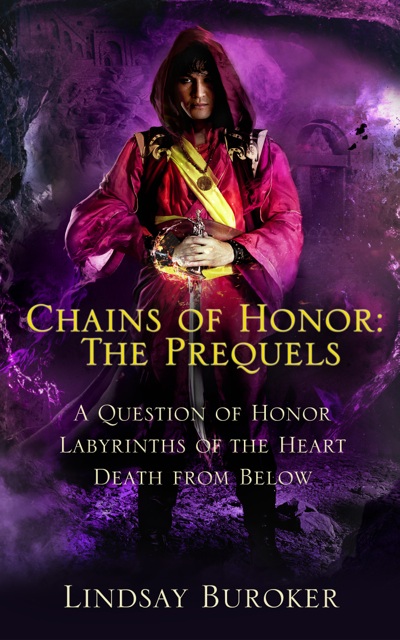
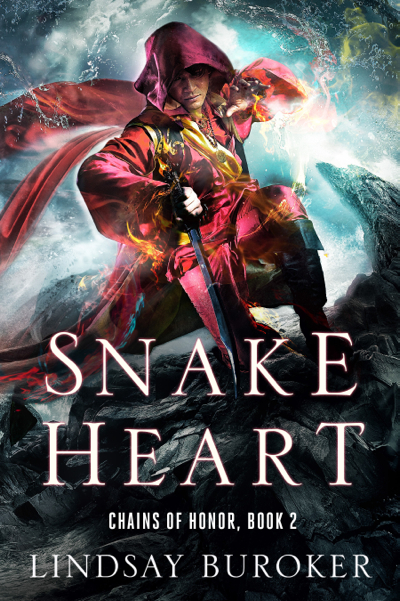
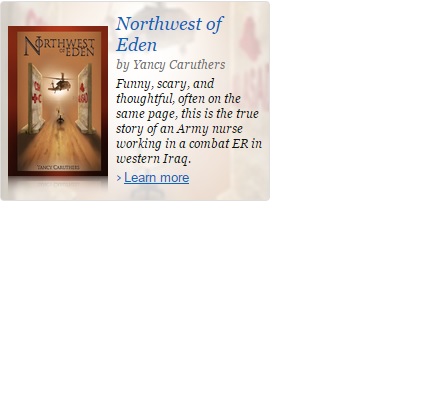
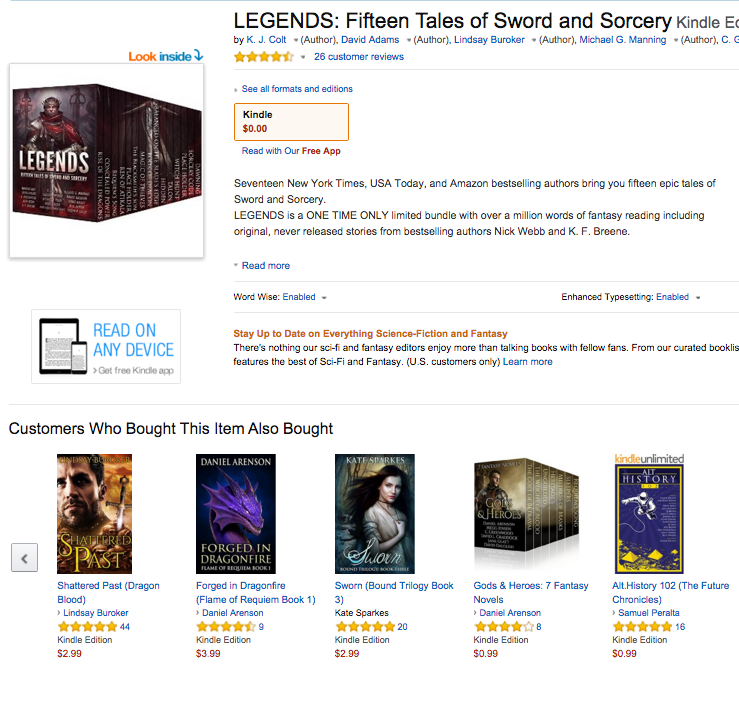
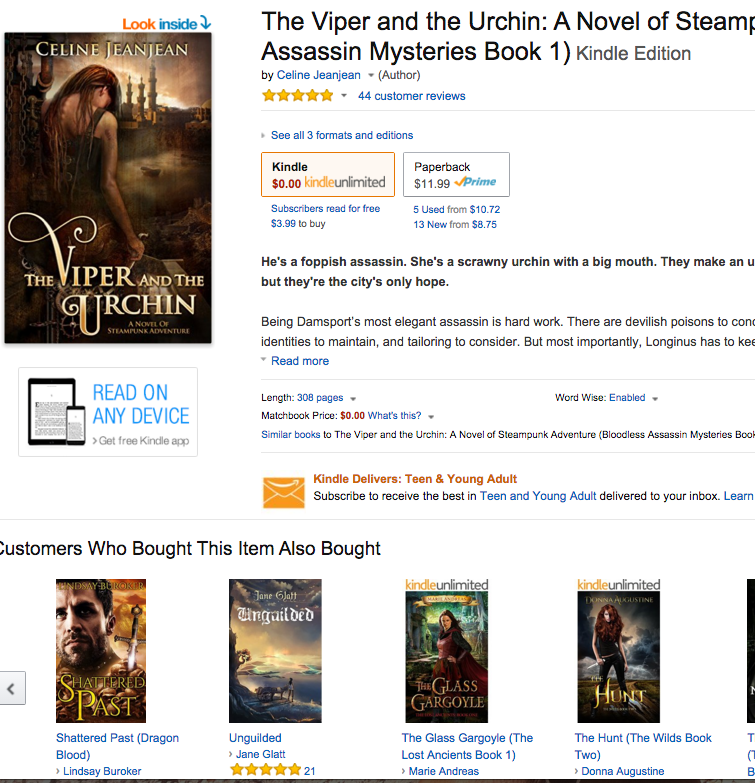 As you can see, SP is already in the first also-bought spot again.
As you can see, SP is already in the first also-bought spot again.
